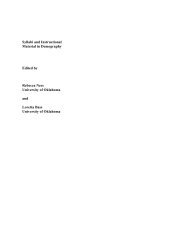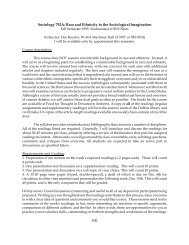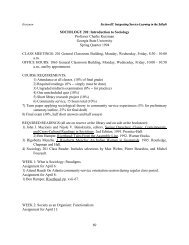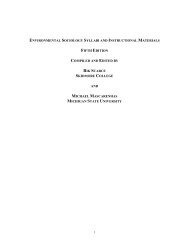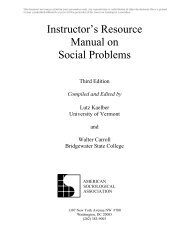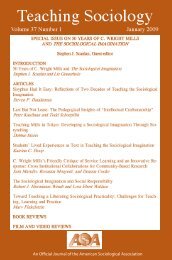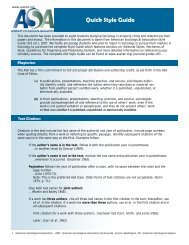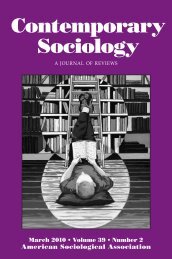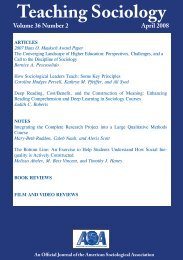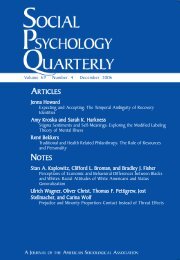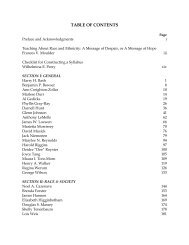SOCIOLOGY EDUCATION - American Sociological Association
SOCIOLOGY EDUCATION - American Sociological Association
SOCIOLOGY EDUCATION - American Sociological Association
Create successful ePaper yourself
Turn your PDF publications into a flip-book with our unique Google optimized e-Paper software.
Gender, Obesity, and Education 253<br />
Obesity and Psychosocial<br />
Adjustment<br />
The previous analyses revealed that girls who<br />
were obese during adolescence were less likely<br />
to enroll in college in young adulthood,<br />
especially when they attended middle schools<br />
and high schools in which obesity was relatively<br />
uncommon. Because obese and<br />
nonobese boys did not differ in terms of college<br />
enrollment after high school no matter<br />
where they attended middle school or high<br />
school, the subsequent investigation of the<br />
psychosocial mechanisms linking obesity to<br />
college enrollment will focus only on girls. As<br />
was described in the Plan of Analyses, testing<br />
mediation first required that I establish that<br />
obesity predicts the psychosocial outcomes.<br />
Table 3 presents the odds ratios from logistic<br />
regressions predicting two internalizing<br />
symptoms—self-rejection and suicidal<br />
ideation—among girls only. As may be seen<br />
in the first column, obesity at Wave I was<br />
associated with greater odds of self-rejection<br />
at Wave II, net of the four sets of selection factors,<br />
as well as the Wave I version of self-rejection.<br />
4 Specifically, the odds of self-rejection<br />
were 63 percent higher for obese girls than<br />
for nonobese girls. Because of the control for<br />
Wave I self-rejection, these odds capture<br />
increases in the odds of self-rejection between<br />
Wave I and Wave II that are associated with<br />
obesity. As may be seen in the second column,<br />
obesity was also associated with<br />
increased odds of suicidal ideation among<br />
girls. Additional modeling iterations included<br />
interaction terms between adolescent obesity<br />
and the two school-level obesity factors. No<br />
interaction term significantly predicted either<br />
of the two internalizing outcomes for girls.<br />
The first panel in Table 4 presents the<br />
exponentiated coefficients from Poisson models<br />
predicting two types of self-medication—<br />
alcohol and marijuana use—among girls.<br />
Obesity was associated with higher expected<br />
frequencies of both. After all selection factors,<br />
as well as the Wave I versions of both substance<br />
use variables, were controlled for,<br />
these two obesity coefficients just narrowly<br />
missed statistical significance at the .05 level.<br />
Again, adding interaction terms between<br />
obesity and the two school-level obesity fac-<br />
tors revealed no significant across-school variations<br />
in the associations between Wave I<br />
obesity and either form of Wave II substance<br />
use for girls.<br />
Finally, the second panel in Table 4 presents<br />
the exponentiated coefficients from Poisson<br />
models predicting two types of academic disengagement—the<br />
number of class failures and<br />
truancy—among girls. Obesity at Wave I predicted<br />
class failures at Wave II, net of the selection<br />
factors and Wave I number of class failures.<br />
More specifically, obese girls had 24 percent<br />
higher expected frequencies of class failures<br />
between Wave I and Wave II than did their<br />
nonobese counterparts who had the same<br />
number of class failures at Wave I. Additional<br />
analyses revealed no significant interaction<br />
between girls’ obesity and either school-level<br />
obesity factor. Wave I obesity did not predict<br />
girls’ truancy rates at Wave II in the full sample.<br />
Yet, in the next modeling iteration (not shown),<br />
the obesity measure did interact significantly (p<br />
< .05), with the school-level factor indexing the<br />
proportion of obese girls in the student body.<br />
To interpret this interaction term, I again calculated<br />
the predicted frequencies of truancy for<br />
obese and nonobese girls in different types of<br />
schools. Nonobese girls did not differ in their<br />
rates of truancy across schools. On the other<br />
hand, obese girls had low truancy rates if they<br />
attended schools in which at least 10 percent of<br />
the student body was other obese girls, but<br />
they had the highest truancy rates of all girls<br />
when they attended schools with no other<br />
obese girls.<br />
In sum, girls who were obese at Wave I<br />
demonstrated significant or marginally significant<br />
increases in self-rejection, suicidal ideation,<br />
alcohol use, marijuana use, and class failure<br />
between Wave I and Wave II. At the same time,<br />
they demonstrated increases in truancy during<br />
this period if they attended schools with a low<br />
representation of obese girls in the student<br />
body. The results provide support—among girls<br />
at least—for Path A1 in Figure 1.<br />
Obesity, Psychosocial Adjustment,<br />
and College Enrollment<br />
Having confirmed Path A1, I now attempt to<br />
establish Path A2. Table 5 presents the partial<br />
results of a logistic regression model predict-



